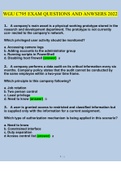Summary
Summary of Group Dynamics - Forsyth - 7th latest edition - 2019
- Course
- Institution
- Book
Extensive and Detailed summary of the book Group dynamics (7th edition) by Forsyth (2019) . Boston, MA.: Cengage Learning complete book is summarised.
[Show more]












